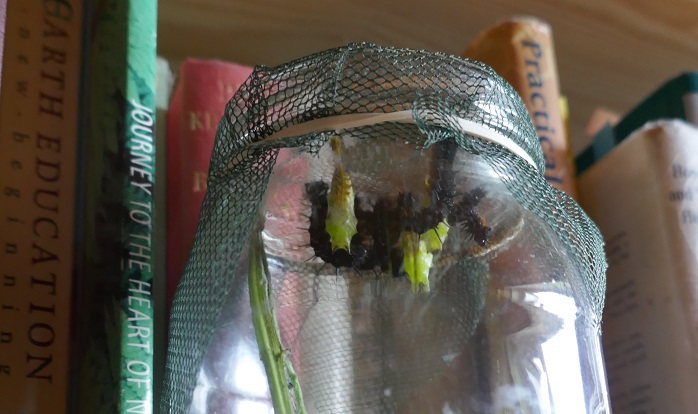
10 Green Pupae Hanging………
After munching through a load of nettles above my desk from 9th July, these potential peacock butterfly beauties stopped feeding on the 15th. They attached themselves to the mesh by silken threads and hung there head down in a blissfully quiescent state for 24 hours. I missed the action as the first 3 pupated on the 16th while I was washing dishes. However, I was there later to watch closely as several followed suit and burst out of theirs in under 5 minutes. It was amazing how the larval skin bursts near the mouth parts exposing the brilliant soft green pupal skin. As if wriggling out of a tight dress that is splitting as it moves, the larva frees itself then hangs up to dry and harden its pupal case. The old skin shrinks so much it resembles only the head on completion and it falls to the floor. I watched the process for one larva/caterpillar under my dissecting microscope and noticed the old “coat” curled up like a snake’s skin. The spiracles or breathing tubes are clearly seen now, as are the heaving pupal respirations. Fluid sloshes around inside the green skin and over the next couple of weeks reorganisation of the internal organs and structures will take place to complete the metamorphosis into butterfly. As I write, 2 fat caterpillars are waiting to join the other 8 pupae. I’m watching for the tell-take head movements heralding the start of the show.
Dissection.
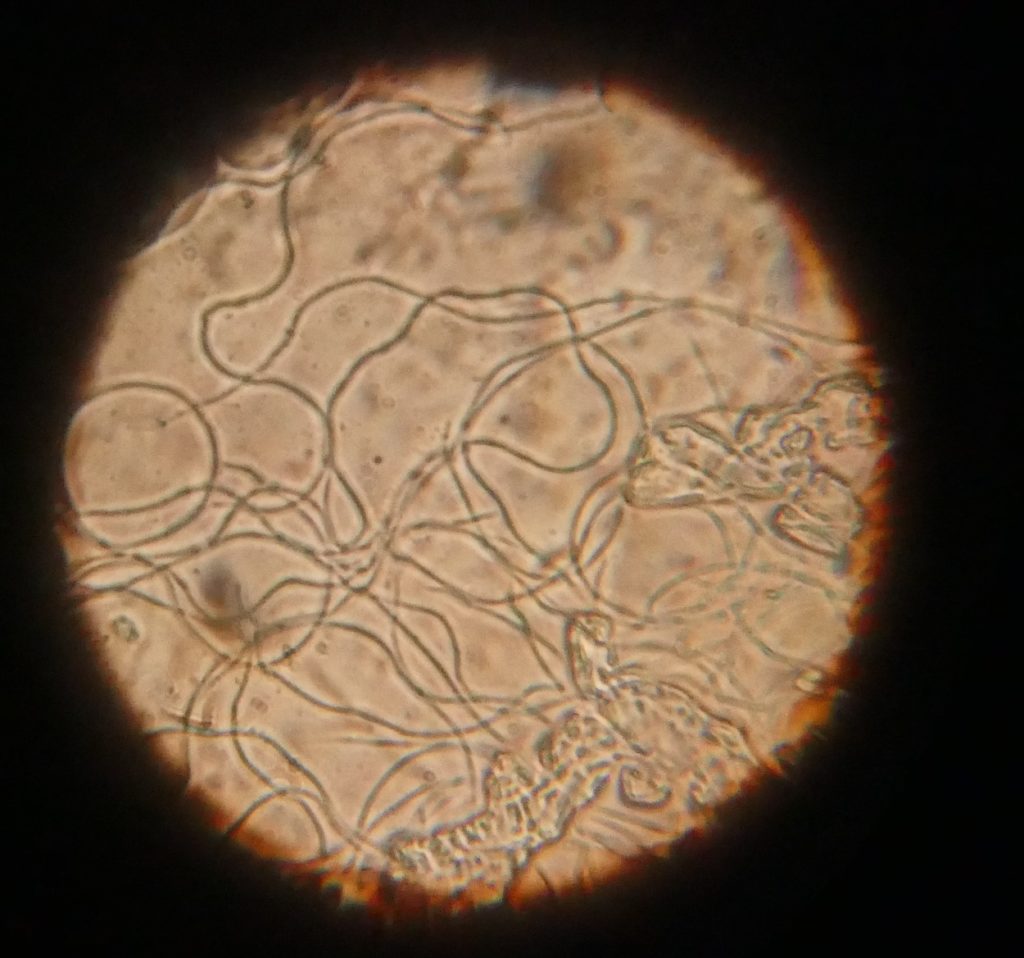
Any guesses as to what this photograph shows? It’s my first attempt at pointing the camera down the compound microscope lens without the aid of fancy gadgets. Perhaps not the best quality but it shows drone spermatozoa. Millions of them on the slide and at first they were constantly moving as they warmed up in a saline solution. The specimen was taken from a mature drone. Did you know that it takes a drone 36 days from egg to sexual maturation? He emerges around day 24 but his reproductive organs are not fully mature then. He lives for around 20 days after that, or less if he mates with a queen honey bee as this act terminates his life.
Failing Queen.
A few weeks ago Gordon Ross brought me a culled queen that had been failing to lay well enough to keep the colony going. Yesterday, I dissected her and removed the organ that stores the sperm. It is called the spermatheca and in a mated queen is a round white organ criss-crossed with tracheae carrying oxygen to preserve the sperm. In unmated queens the spermatheca is a clear round see-through ball. I wasn’t able to photograph it so I have drawn what I saw, though not quite to scale! I’ve separated the ovaries because they hang like curtains and cover the reproductive organs obscuring the spermatheca. The ovaries are quite incredible and are absolutely stuffed full of eggs in a healthy reproductive queen.
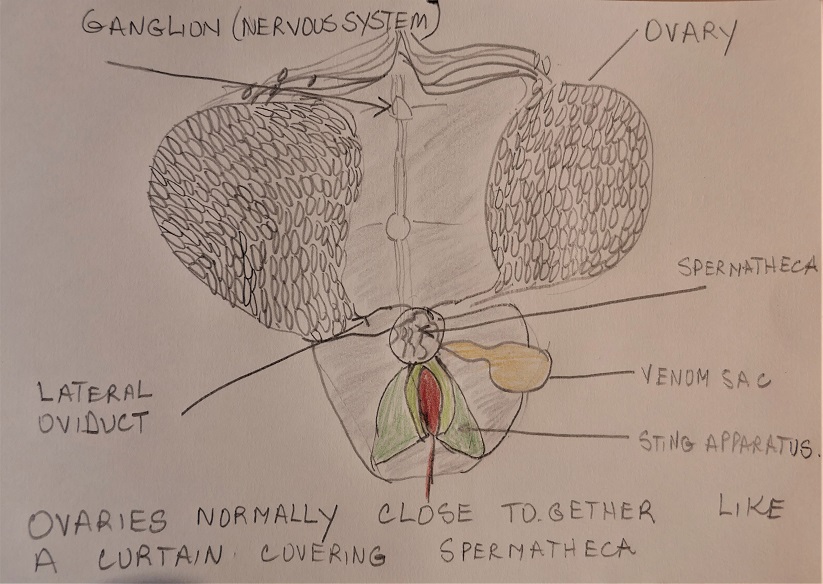
I removed the spermatheca and opened it onto a watch glass containing saline then place a drop on a slide. I found lots of sperm. Having been frozen for weeks, they were dead so it didn’t tell me why the queen had failed. Gordon thought that she might have run out of semen but this was not the case. Sometimes if the colony has a nosema infection the queen can become sterile. If queens are mailed in the post/transported and exposed to high temperatures this can also affect their fertility.

It’s been a great week for swarming in Nairnshire with some still hot muggy days up in the early twenties (Celsius). I’ve been keeping an eye on the colony that has had CBPV. You’ll remember that I took the drastic measure of euthanising all but the queen and foragers some months back. Well, they are thriving and I’ve seen no crawling bees out front for a long time. When they showed signs of swarming on 21st June, I took out the old queen using the nucleus method of swarm control. I meant to go back on 28th to remove all other queen cells leaving the chosen one I’d seen on 21st…..
Anyway, long story short: I noticed a lot of activity a few days ago on 14th and the next thing was they swarmed in a massive but quite disorganised cloud.
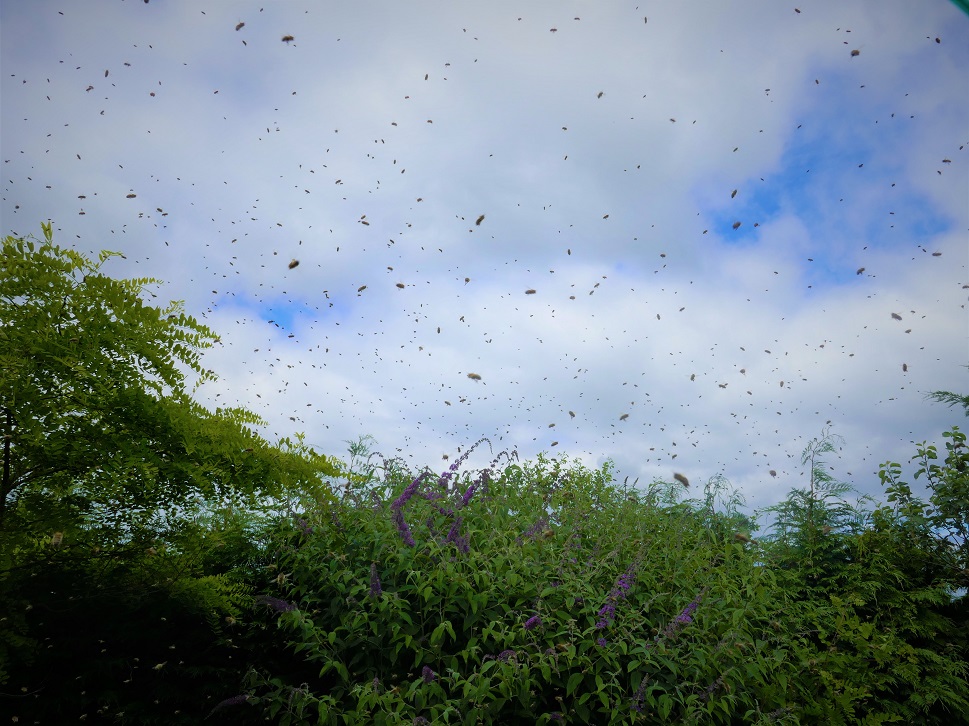
They just didn’t seem to be settling. Even when they rested on the hedge they were milling about so I figured that the queen wasn’t with them. She wasn’t and they went back home again. Next day at the same time, 13:20, they repeated the routine but this time the roar as they left the double story (10 brood frames) nuc was deafening and they meant business. So, I collected the ladder from the garage and my straw skep, and then I called Cynthia. Cynthia was walking the dogs and I was on my own so needed to work out the safest method of collection. So, I placed the skep above the swarm where it balanced precariously. I let some bees collect and cling to the straw before removing the skep and placing it in front on the prepared nuc on a white sheet. Luckily I spotted the virgin queen in this prime swarm so I caged her and placed her in the nuc box between the middle frames. This way I was safely able to collect 2 more manageable skep-loads of bees for the nuc. The rest flew home to the parent colony.
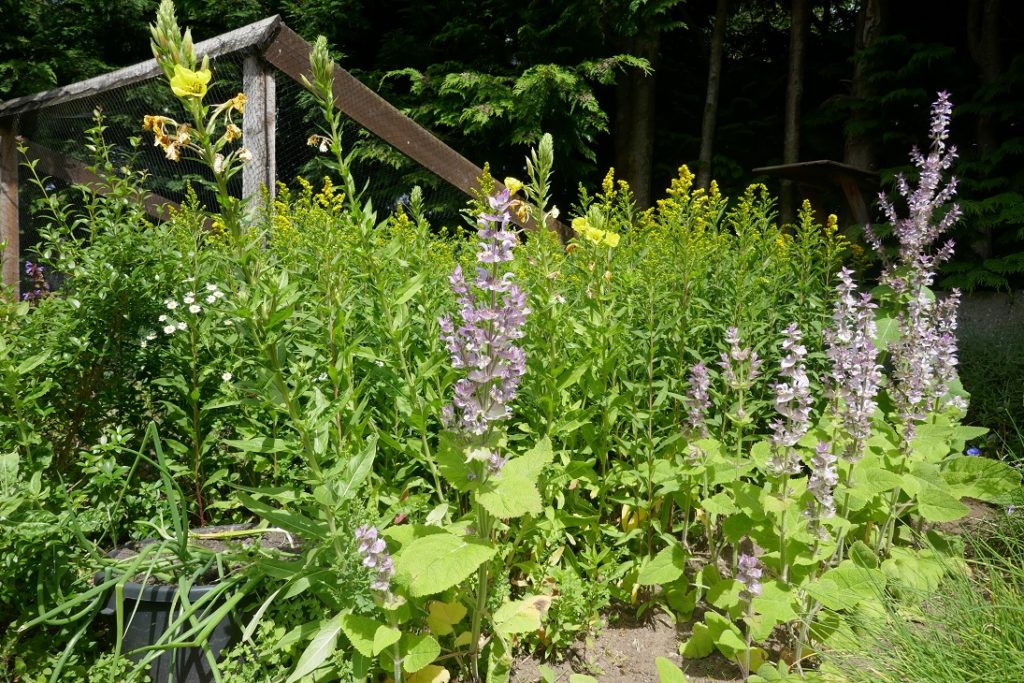
Patch of Goldenrod.
My patch of goldenrod (Solidago spp) is about to bloom. You can see the large yellow evening primroses and the monster sages that are a pollinators’ paradise.
One of my neighbours has turned her front garden into a real work of art and produce. Amanda is also a beekeeper and a highly skilled professional gardener. She gave me the bunch of sweet peas by the way.


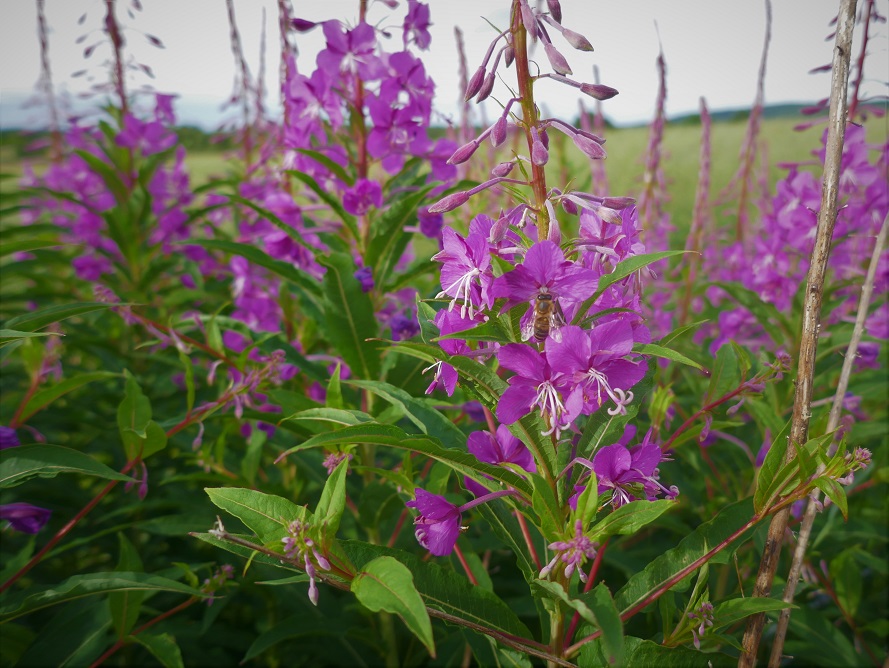
Summer rolls along all too quickly and the rosebay willowherb is well underway. My bees will have a rest now from regular swarm control inspections.

On Colonsay, Andrew Abrahams gave us each a teaspoonful of goldenrod honey. The texture, colour and taste were very special, so I hope your plants will spread 🙂
Well, they have spread in my garden already as I have transplanted clumps here and there where I want cover and more forage, Margaret-Anne.
Brilliant! Lovely blog with lots of useful stuff. Than you.
That’s good, Avery. Thanks.
We have had three swarms abandon the idea this year, two of them were boxed as soon as they settled at which point the queen appeared to take fright and go home. One swarmed again and one has stayed put and shown no signs of swarming since.
The Goldenrod is an interesting example of local foraging cultures as our bees don’t go near it.
I wonder if it might be more successful to let them settle in your collecting box/skep before hiving them at the end of the day? Or, try a queen excluder over the floor for a couple of days. You probably have more interesting forage available in the south when goldenrod flowers. I’ve been told that Andrew Abrahams on Colonsay gets goldenrod honey on his marginal Scottish island.
Thank you for the advice, the use of a queen excluder never occurred to me. The lesser spotted woodpeckers take their fledged chicks to the red hot pokers in the garden to drink nectar. It would be interesting to see whether Herefordian bees were able to adapt to more spartan forage environments. The tiny green shoots of evolution.
I’d no idea about lesser spotted woodpeckers enjoying nectar. That would make a wonderful photo. We only have the greater spotted here and they go for the peanuts.
I have been trying for ten years to get that photo. They probably started by hunting on the flower stems.